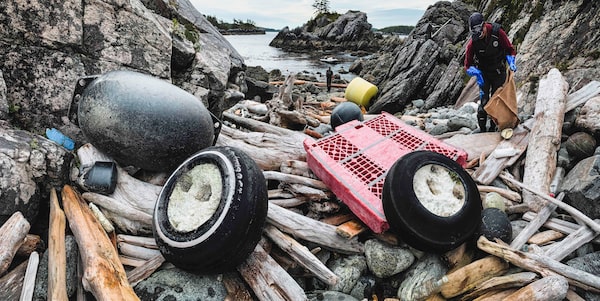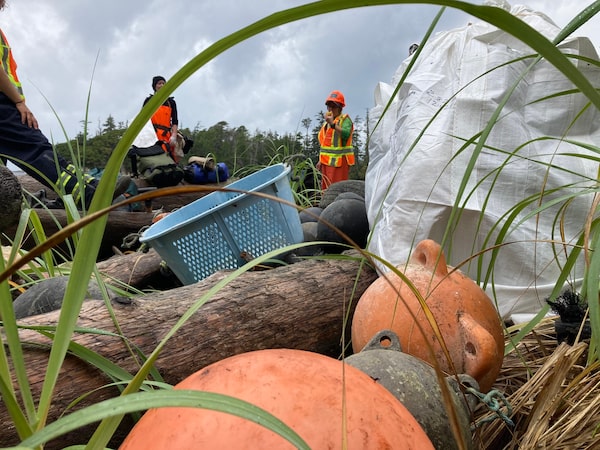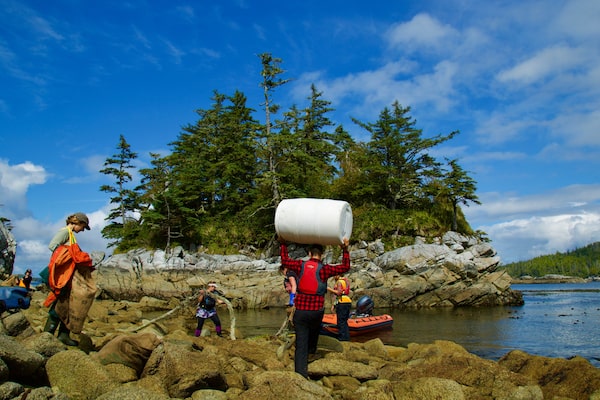
The project is an industrial-level cleanup that will see some 130 tonnes of plastic debris removed from the shoreline.Simon Ager/Maple Leaf Adventures
This is part of Stepping Up, a series introducing Canadians to their country’s new sources of inspiration and leadership.
As Kevin Smith headed north up British Columbia’s central coast in August, he got news that the Department of Fisheries and Oceans was on the lookout for four humpbacks in the region that were entangled in fishing gear. The crew from his ship – along with eight others from five different ecotourism companies – started searching immediately. Having encountered entangled whales before, they knew this was a life-or-death situation.
News that the whales were missing hit Mr. Smith and the other captains hard: They knew two of them by name – X-Ray and Checkmate. In normal years, the nine small ships would introduce visitors to the beauty and culture of the Great Bear Rainforest region of B.C.'s coast, and they’d regularly spot the two humpbacks along the way.
But this year, trips like theirs were banned, so the ships were headed north with a different purpose: to clean up a remote coast littered with marine debris and plastic garbage.
“We had the chance to give back to the place that gives us our life force,” says Mr. Smith, co-owner of Maple Leaf Adventures, by satellite phone from aboard one of the ships in Fitz Hugh Sound.

Thanks to a project dreamed up by Kevin Smith, the fleet of luxury ecotourism ships began two 21-day cleanup expeditions on Aug.18, 2020.Grace Gladstone/maple leaf adventures
Thanks to a project dreamed up by Mr. Smith, the fleet of luxury ecotourism ships began two 21-day cleanup expeditions on Aug.18. A hundred crew members spent eight to 10 hours a day hauling debris, from soccer balls to commercial fishing nets, off the craggy, wave-tossed beaches. The project is an industrial-level cleanup that will see some 130 tonnes of plastic debris removed from the shoreline.
“This isn’t walking a beach with a garbage bag,” says Mr. Smith, who’s done plenty of that as a former marine park ranger. “It’s rugged, physical work. We’re pulling out nets, floats and hundred-foot tow lines that are three to four inches in diameter.” That’s exactly the kind of debris X-Ray became entangled in. He was the only one of the missing humpbacks to be spotted and untangled; the other three never resurfaced.
Like other tourism enterprises, members of the Small Ship Tour Operators Association of B.C. (SSTOA) were hit hard by the COVID-19 shutdown. Even now that some sectors of the tourist trade have restarted, it’s almost impossible to maintain physical distance on a traditional ship. Plus, closings of Indigenous territories – where many of the boats travel during tours – have prevented operators from switching to serve a local clientele.
So when Mr. Smith floated the idea of a massive garbage removal project, the other tour operators enthusiastically agreed. “We have the skills, the boats and the time,” Mr. Smith says. “It was a chance to do the type of cleanup I’ve always dreamed about.”

Everyday items such as toothbrushes, razors, flip flops and water bottles, as well as footballs, volleyballs, soccer balls and golf balls, make up a portion of the garbage.Sarah Hauser/Mothership Adventures
Growing up sailing the coast, Mr. Smith has seen the result of exploding plastic use. As steward of the marine parks of northern Vancouver Island, and again as a negotiator on the central coast (Great Bear Rainforest) land use plan, the problem of marine debris has grown ever more more alarming.
Indigenous leaders in the region agree, and when Mr. Smith and the SSTOA approached them, they were excited about a project that protected their territory while providing employment for out-of-work members.
Together, the Heiltsuk, Wuikinuxv, Kitasoo/Xai’xais, Nuxalk, Gitga’at, Metlakatla, Old Massett, Skidegate and Council of the Haida Nation, along with ship operators, developed a proposal for government that ensured the vessels would stay away from populated areas. While the ships cleaned the outer shores, 75 members from the Nations would use their own boats to clean around villages and sacred sites, as well as their critical food-harvesting areas.
“It’s a great initiative,” says William Housty, the resource management department chair for the Heiltsuk First Nation of Bella Bella. “Younger members are being mentored by more experienced captains. They’re connecting with parts of our territory they rarely get to.”
Funding came through with a bit of luck. Even though fisheries fall under federal control, all federal monies for the year had already been allocated when Mr. Smith came up with the cleanup plan. But in June, B.C.'s provincial government put out a call for ideas on how to spend $1.5-billion in COVID-19 economic recovery funding. The coastal cleanup proposal by SSTOA was one of 50,000 submissions received.
“This is exactly what a government should spend money on,” says Sheila Malcolmson, B.C. parliamentary secretary for the environment. The MLA for Nanaimo, who’s also passionate about the problem of marine debris, recently completed a multimonth report titled What We Heard on Marine Debris in B.C., which outlined the coastal issues and offered up several solutions, from removing derelict boats to recycling useful parts of abandoned fishing gear. “The cleanup keeps skilled people employed and solves a problem,” she says.
The $3.5-million allotted to the project doesn’t replace the $15-million to $16-million the ships would typically bring in through tourism. But for the ship owners, money wasn’t the point. Describing themselves as fiercely proud of the place they work, Mr. Smith and the others are also fiercely protective of it. But increasing amounts of human-caused debris and abandoned fishing gear had grown into a massive problem with no easy solution.
Russell Markel, owner of Outer Shores Expeditions, says one of the highlights of the project has been seeing how energized everyone is as they problem-solve things such as how to dig out nets in rough conditions or get rotting Styrofoam out of huge piles of logs. “I’ve never seen people so excited about garbage,” he says.

A hundred crew members spent eight to 10 hours a day hauling debris, from soccer balls to commercial fishing nets, off the craggy, wave-tossed beaches.Sam Lam/Mothership Adventures
The only downside is the staggering amount of debris they’ve encountered. “These are areas people think of as pristine,” Mr. Markel says. “Imagine anything made out of plastic – we’re finding it.”
Everyday items such as toothbrushes, razors, flip flops and water bottles, as well as footballs, volleyballs, soccer balls and golf balls, make up a portion of the garbage. But the familiar debris of modern life is dwarfed by fishing gear, which comprised 80 per cent of the first 61 tonnes collected.
As physically taxing as it is, removing the gear is deeply satisfying, Mr. Smith said. And cleaning some of it up has brought his journey full circle: from the urgency of looking for entangled whales, to the grief of losing them, to the pride of making the region safer for the whales still there. This unique season may be his most fulfilling yet.
Our Morning Update and Evening Update newsletters are written by Globe editors, giving you a concise summary of the day’s most important headlines. Sign up today.